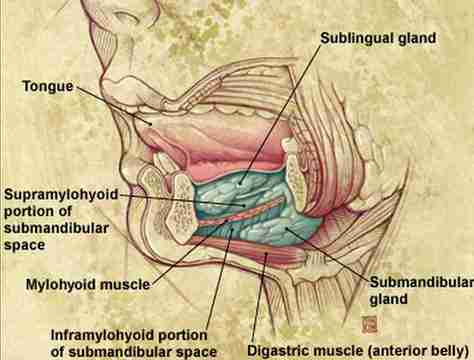Ludwig’s Angina
What is Ludwig’s Angina?
Ludwig’s angina is a life-threatening infection of the connective tissue of the submandibular or sublingual area (located on the floor of the mouth). It was named after Wilhelm Friedrich von Ludwig, a German physician who first knew about the disease in 1836. Ludwig’s angina is also known as angina ludovici, angina maligna or morbus strangularis because of the inflammation it causes in the floor of the mouth causing a strangulating feeling (from the word angina meaning “strangling”).
Ludwig’s angina is different from angina pectoris or chest pains. However, chest pains may be present in advanced cases of Ludwig’s angina, where the infection reaches the retrosternal space.
Ludwig’s angina is simply known as submandibular and sublingual space infection.
Ludwig’s Angina Pathophysiology
Ludwig’s angina starts from a dental infection. Almost half of the patients suffering from Ludwig’s angina have existing or previous infections of the teeth and gums. Periodontal infections are commonly caused by streptococcus and staphylococcus organisms which are present in the mouth even when the person is healthy.
Once the bacteria travel and spread, it reaches the submandibular and sublingual areas causing inflammation and swelling. Because of the inflammatory response, the body produces chemical mediators responsible for pain, erythema and swelling, which are evident to a patient. The infection and inflammation extends to adjacent tissues such as the pharynx and neck. Abscess formation develops usually on these areas. Patients typically breathe through the mouth as a result of swelling of the airways. Because of inflammation of the tongue, it falls back at the base which causes airway obstruction. Massive swelling also makes the upper airways constricted.
The infection further reaches the lungs and mediastinum. Retrosternal abscess develops and results in chest pains and chest heaviness. Descending infections in the lungs cause pneumonia and formation of pulmonary secretions that further aggravates the difficulty in breathing. More severe cases may eventually lead to sepsis and shock.
Ludwig’s Angina Symptoms and Signs
Symptoms of Ludwig’s angina include:
- Swelling of the submandibular and sublingual areas
- Pain on the tongue and neck
- Redness and swelling of the neck
- Fever
- Malaise, weakness and fatigue
- Dysphagia or difficulty in swallowing
- Drooling
- Difficulty breathing
- Tachypnea (rapid respirations)
- Stridor (a harsh sound heard during inspiration which signals an obstructed airway)
- Confusion or mental changes due to hypoxia
- Earache as a sign of spread of the disease to the ears
- Unusual speech
Contact a health provider when severe symptoms such as stridor, shortness of breath and chest pains occur.

Picture 1 – Observe swelling at submandibular region
Ludwig’s angina Causes & Risk Factors
Bacterial Causes
Ludwig’s angina is generally caused by a streptococcal bacterial infection, but other microorganisms can also cause it such as Staphylococcus, Bacteroides, Pseudomonas, Escherichia coli, Klebsiella, Enterococcus, Candida and Clostridium species. Since it is primarily caused by streptococcus bacteria, it is considered a form of cellulitis in the submandibular and sublingual areas.
Other Factors
- Submandibular swelling is most often associated with periodontal infections such as tooth abscess and is responsible for about 90% of the cases.
- Other risk factors include previous neck trauma, mandibular fracture, parapharyngeal infections, tongue piercing and even neoplasms, all of these may introduce microorganisms to the mouth and cause infection.
- People with immunocompromised status such as in HIV, organ transplant recipients, diabetes mellitus, alcoholism, glumerulonephritis, anemia, blood dyscrasias and systemic lupus erythematosus have higher risk in developing the disease.
- Adults and elderly are the most common age group who suffer from the diseases as this is uncommon to children.
Ludwig’s Angina Diagnosis
Radiology
Single plate x-rays are sometimes not efficient in determining the extent of the infection. A Computed Tomography (CT) scan of the neck and head is the best exam to determine areas affected such as the upper neck, chin and floor of the mouth. This may also assess spread to the thoracic area. Ct scans involve the use of several x-ray beams to check all angles of the area being examined.
Bacterial Culture
Fluid samples from the affected areas are taken to determine specific microorganisms that cause the infection. Almost half of the cases are caused by streptococcus bacteria.
Ludwig’s Angina Treatment
Ludwig’s angina is a life-threatening disease, but can be treated using appropriate therapy. Most of the mortalities in the earlier years are associated with poor diagnosis and lack of antibiotics to treat the disease. Today, advanced diagnostic procedures and antibiotics had made Ludwig’s angina as a rare disease. The primary treatment for Ludwig’s angina is the administration of antibiotics and airway management.
Antibiotics
Antibiotics are given to eradicate bacterial infection. Penicillin is the drug of choice, but other broad spectrum antibiotics can be used such as macrolides and cephalosporins. Proper allergy testing is done to avoid anaphylaxis since the antibiotics are usually given via the intravenous route. Broad spectrum antibiotics are given initially when the result of the culture and sensitivity is not yet available. These antibiotics are those who are able to kill several bacteria including gram negative and gram positive ones. When culture and sensitivity testing is available, then a more specific antibiotic is given, one in which the causative microorganism is most sensitive. Ludwig’s angina antibiotics are given for several days depending on the severity of the infection. It may be shifted to oral antibiotics as long as the patient is able to swallow and breathe effectively.
Steroid Therapy
Steroids have been used for its anti-inflammatory effects. Steroids significantly reduce inflammation on the site and improve the breathing pattern. However, steroids have not been used extensively today because it decreases the immune system that further leads to more infection.
Airway Obstruction Management
Airway management is essential in saving the life of the patient. Obstruction in the airways is a medical emergency and if airway obstruction is present, emergency measures should be carried out immediately. A tracheostomy tube or cricothyroidotomy can be placed by surgically creating an opening on the anterior neck into the trachea or wind pipe. A tube is then inserted to maintain the airway patent. Aside from this, an endotracheal tube may also be done in more severe cases of obstruction. This involves the insertion of a flexible tube into the mouth or nose going to the lungs. A guided intubation is used because blind intubations may lead to injury of the nasal, oral and tracheal mucosa. Secretions are suctioned as necessary to prevent accumulation and hypoxia. Characteristics of secretions are also assessed to determine infection. A greenish to yellowish phlegm indicates bacterial infection of the lungs. Breath sounds should be assessed every now and then to determine proper entry of oxygen.
Surgical Management
More than 50% of Ludwig’s angina cases develop swelling that is suppurative. Because of this, imaging studies are needed such as CT-scans to determine the extent and site of the complication. Most common site would be the neck. Drainage of the neck is done to remove accumulated fluids or pus. Incision and drainage is a minor operation that requires a sterile technique to prevent re-infection.
Supportive Management
Tooth extractions and dental treatment is also performed to stop the root cause.
Ludwig’s Angina Complications
Submandibular, sublingual swelling and inflammation leads to potentially life-threatening complications such as:
Airway Obstruction
This is the most common complication of Ludwig’s angina. As the mouth and the throat inflames, the airways become obstructed. Patients often exhibit mouth breathing and the tongue often falls back causing obstruction.
Sepsis
When the infection becomes severe, the microorganisms travel through the circulation and cause infection to other parts of the body. They grow and proliferate on the blood which causes bacteremia and finally lead to septic shock.
Mediastinal and Pharyngomaxillary Space Extension
Bacteria spread on to adjacent structures and spaces. When the mediastinum is affected, patients usually complain of shortness of breath and chest pains.
Osteomyelitis
Microorganims reach the bones through the circulation and significantly cause infection.
Ludwig’s Angina Prevention
The most effective prevention is to have regular dental check-ups to prevent periodontal diseases. Dentists should be consulted every six months for prophylactic therapy. When tooth and mouth infections occur, they should be treated accordingly with antibiotics to prevent spread to the rest of the oral cavity.
Ludwigs Angina Pictures

Picture 2 – Anatomy of sublingual & submandibular region

Pic 3 – Observe Gross swelling at submandibular region in ludwigs angina condition